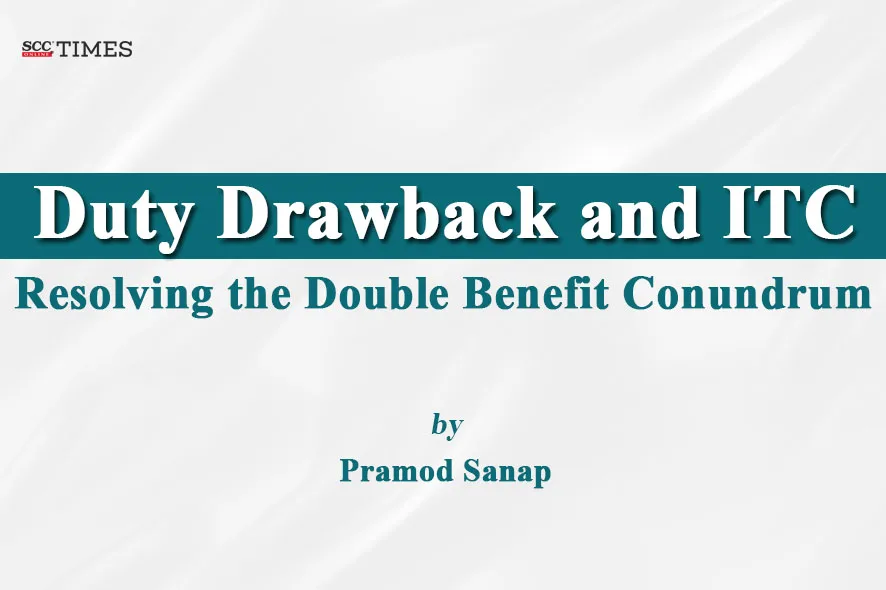The intersection of duty drawback provisions and input tax credit (ITC) refunds under goods and services tax (GST) has created significant confusion for exporters, with authorities often denying legitimate claims based on misconceptions about double benefits. A careful analysis of the legal framework reveals that the current restriction on duty drawback claims when ITC is availed lacks statutory foundation and contradicts the legislative intent.
Evolution of the duty drawback framework
The duty drawback mechanism operates through two distinct statutory regimes. Sections 741 and 752 of the Customs Act, 19623 govern rebates on basic customs duty, while Section 11-B of the Central Excise Act, 19444 previously regulated rebates on excise duty paid on inputs used in manufacturing exported goods. Post-GST implementation, this framework has undergone significant transformation.
Notification No. 131/2016-Customs5 introduced a dual-rate structure distinguishing between higher rates (Columns 4 and 5) covering customs, central excise and service tax components, and lower rates (Columns 6 and 7) limited to customs components only. The Notification explicitly states that when rates in Columns 4 and 6 are identical, the drawback pertains exclusively to customs duty and remains available regardless of Central Value Added Tax (CENVAT) facility availment.
The post-GST paradigm shift
The implementation of GST fundamentally altered the duty drawback landscape. The Customs and Central Excise Duties Drawback Rules, 20176 redefined “drawback” to explicitly exclude integrated tax, limiting the scope to customs duty rebates only. This definitional change eliminated the higher rate drawback that previously encompassed multiple tax components.
Following the transition period ending 30-9-2017, only lower rate drawback remained available, addressing exclusively the customs duty component. This structural change undermines the rationale for denying drawback claims based on ITC availment, as the two mechanisms now operate on entirely different tax components.
Judicial clarification on double benefit
The Gujarat High Court’s decision in Awadkrupa Plastomech (P) Ltd. v. Union of India7 established crucial precedent by recognising that identical rates in Columns 4 and 6 signify exclusive customs component coverage. The Court held that claiming such drawback alongside integrated goods and services tax (IGST) refund does not constitute double benefit, as customs duty remains outside GST’s ambit.
This principle has been consistently followed in subsequent decisions including Gujarat Nippon International (P) Ltd. v. Union of India8, Sunlight Cable Industries v. Commr. of Customs9 and Kunal Housewares (P) Ltd. v. Union of India10. The Madras High Court in Numinous Impex (I) (P) Ltd. v. Commr. of Customs11 further clarified that ITC refund cannot be denied merely because duty drawback has been claimed under the Customs and Central Excise Duties Drawback Rules, 2017.
The circular versus statute conflict
Circular No. 37/2018-Customs12 attempted to restrict ITC refunds for exporters claiming drawback benefits. However, the Madras High Court in Precot Meridian Ltd. v. Commr. of Customs13 invalidated this approach, emphasising that circulars cannot override statutory provisions. The Court relied on the Supreme Court’s ruling in CCE v. Ratan Melting & Wire Industries14, which established that circulars represent merely the executive’s understanding and cannot prevail over judicial interpretation of statutes.
Significantly, Circular No. 37/11/2018-GST15 explicitly clarified that drawback availment on basic customs duty does not restrict ITC refund eligibility, recognising the distinct nature of these tax components.
Legislative intent and practical implications
The legislative design demonstrates clear intent to prevent double benefits only where multiple schemes address the same tax component. The pre-GST higher rate drawback encompassed various tax elements that are now subsumed under GST, justifying restrictions on simultaneous availment. However, post-GST lower rate drawback addresses only customs duty, which remains outside GST’s scope.
Section 54(3) of the Central Goods and Services Tax Act, 2017 (CGST Act)16 restricts refunds only when drawback includes the same tax component being refunded. Since current drawback excludes integrated tax by statutory definition, this restriction cannot apply to customs-only drawback claims.
Recommendations for reform
The current administrative practice of denying duty drawback based on ITC availment lacks legal foundation and contradicts established judicial precedent. Authorities should:
First, recognise that lower rate duty drawback pertains exclusively to customs duty and cannot create double benefit scenarios when claimed alongside ITC refunds. Second, ensure that identical rates in Notification Columns 4 and 6 are processed without ITC-related restrictions, as mandated by the Notification’s own conditions. Third, align administrative practices with statutory provisions rather than relying on circulars that exceed their legal authority.
Conclusion
The duty drawback framework post-GST implementation operates on fundamentally different principles than its predecessor. The elimination of higher rate drawback encompassing multiple tax components, coupled with the redefinition excluding integrated tax, has created a system where customs duty drawback and ITC refunds address entirely distinct tax liabilities.
Continued denial of legitimate drawback claims based on outdated double benefit concerns undermines export facilitation objectives and contradicts clear statutory and judicial guidance. The legal position firmly supports exporters’ entitlement to both lower rate duty drawback and ITC refunds, as there exists no overlap in the tax components addressed by these mechanisms. Administrative alignment with this legal reality is essential for maintaining India’s export competitiveness and upholding the rule of law in tax administration.
*5th year BA LLB (Hons.) student, Maharashtra National Law University, Mumbai. Author can be reached at: pramod.sanap@mnlumumbai.edu.in.
4. Central Excise Act, 1944, S. 11-B.
5. Ministry of Finance, Notification No. 131/2016-Customs (NT), G.S.R. 1018(E) (Notified on 31-10-2016).
6. Customs and Central Excise Duties Drawback Rules, 2017.
7. (2021) 89 GSTR 163 : 2020 SCC OnLine Guj 3517 : (2021) 46 GSTL 31.
8. 2022 SCC OnLine Bom 11970 : (2022) 64 GSTL 45.
9. (2024) 127 GSTR 312 : 2023 SCC OnLine Bom 1328 : (2023) 75 GSTL 574.
11. 2022 SCC OnLine Mad 9134 : (2022) 66 GSTL 46.
12. Ministry of Finance, General Circular No. 37/2018-Customs (Issued on 9-10-2018).
13. 2019 SCC OnLine Mad 39172 : (2020) 34 GSTL 27.
15. Ministry of Finance, General Circular No. 37/11/2018-GST (Issued on 15-3-2018).



